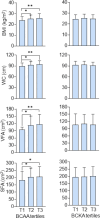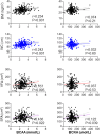BCAA was more closely associated with visceral fat area than subcutaneous fat area in patients of type 2 diabetes mellitus: a cross-sectional study
- PMID: 39501211
- PMCID: PMC11539729
- DOI: 10.1186/s12902-024-01768-1
BCAA was more closely associated with visceral fat area than subcutaneous fat area in patients of type 2 diabetes mellitus: a cross-sectional study
Abstract
Background: Branched-chain amino acid (BCAA) has been reported to be associated with obesity, the association of BCAA with visceral fat area (VFA) and subcutaneous fat area (SFA) remained unclear in patients with type 2 diabetes.
Methods: This cross-sectional study was conducted in 284 patients with type 2 diabetes mellitus. Enzyme-linked immunospecific assay was used to measure levels of serum BCAA and branched-chain keto acid (BCKA). VFA and SFA were measured with bio-impedance analysis method. The association between BCAA and VFA was calculated using Pearson correlation and multivariable linear regression analysis.
Results: There were significant differences in the means of body mass index, waist circumstance, SFA and VFA among the three groups divided by total BCAA tertiles (all p < 0.05). Compared to patients with lower levels of serum BCAA (the lower tertile group), the means of VFA and SFA were significantly larger in the middle and upper tertile groups (all p < 0.05). However, the differences in above obesity parameters were nonsignificant according to various BCKA tertiles. Pearson correlation analysis also demonstrated that BCAA levels were positive associated with each obesity parameter (p < 0.05). Nevertheless, multivariable linear regression analysis showed that levels of serum BCAA were correlated with VFA, BMI and WC (all p < 0.05) rather than SFA after adjusted for other confounders.
Conclusions: levels of serum BCAA were more closely correlated with VFA than SFA, prospective studies should be warranted to further explore the mechanism mediating BCAA and visceral fat accumulation in Human beings.
Clinical trial number: Not applicable.
Keywords: Branched-chain amino acids; Obesity; Subcutaneous fat area; Type 2 diabetes; Visceral fat area.
© 2024. The Author(s).
Conflict of interest statement
The authors declare no competing interests.
Figures


Similar articles
-
Serum Cystatin C levels increase with increasing visceral fat area in patients with type 2 diabetes mellitus.Sci Rep. 2024 Aug 11;14(1):18638. doi: 10.1038/s41598-024-69623-w. Sci Rep. 2024. PMID: 39128944 Free PMC article.
-
High visceral fat with low subcutaneous fat accumulation as a determinant of atherosclerosis in patients with type 2 diabetes.Cardiovasc Diabetol. 2015 Oct 7;14:136. doi: 10.1186/s12933-015-0302-4. Cardiovasc Diabetol. 2015. PMID: 26445876 Free PMC article.
-
Prognostic Impact of Visceral Fat Amount and Branched-Chain Amino Acids (BCAA) in Hepatocellular Carcinoma.Ann Surg Oncol. 2015 Dec;22 Suppl 3:S1041-7. doi: 10.1245/s10434-015-4796-5. Epub 2015 Aug 25. Ann Surg Oncol. 2015. PMID: 26305023
-
Visceral adiposity and inflammatory bowel disease.Int J Colorectal Dis. 2021 Nov;36(11):2305-2319. doi: 10.1007/s00384-021-03968-w. Epub 2021 Jun 9. Int J Colorectal Dis. 2021. PMID: 34104989 Review.
-
Short sleep duration in association with CT-scanned abdominal fat areas: the Hitachi Health Study.Int J Obes (Lond). 2013 Jan;37(1):129-34. doi: 10.1038/ijo.2012.17. Epub 2012 Feb 21. Int J Obes (Lond). 2013. PMID: 22349574
Cited by
-
Circulating BCKAs are closely associated with adipose tissue insulin resistance in type 2 diabetes.Diabetol Metab Syndr. 2025 Aug 1;17(1):308. doi: 10.1186/s13098-025-01860-z. Diabetol Metab Syndr. 2025. PMID: 40751273 Free PMC article.
References
-
- World Health organization. obesity-and-overweight (accessed on 9 June 2021). https://www.who.int/news-room/fact-sheets/detail/
-
- (WHO) WHO. Waist circumference and waist-hip ratio: report of a WHO expert consultation, Geneva, 8–11 December 2008. Geneva: World Health Organization; 2021.
-
- Paik J, Fierce Y, Treuting PM, et al. High-fat diet-induced obesity exacerbates inflammatory bowel disease in genetically susceptible Mdr1a-/- male mice. J Nutr. 2013;143(8):1240–7. 10.3945/jn.113.174615. [published Online First: 20130612]. - PubMed
MeSH terms
Substances
Grants and funding
- 2020tszk01/Clinical Characteristic of Health System in Putuo District, Shanghai
- 2020tszk01/Clinical Characteristic of Health System in Putuo District, Shanghai
- 2020tszk01/Clinical Characteristic of Health System in Putuo District, Shanghai
- ZK2019B16/Shanghai Medical Key Specialties
- ZK2019B16/Shanghai Medical Key Specialties
- ZK2019B16/Shanghai Medical Key Specialties
- 202240309/Research Project of Shanghai Municipal Health Care Commission
- 202240309/Research Project of Shanghai Municipal Health Care Commission
- 202240309/Research Project of Shanghai Municipal Health Care Commission
- ptkwws202003, ptkwws202302/Technology Innovation Project of Putuo District Health System
- ptkwws202003, ptkwws202302/Technology Innovation Project of Putuo District Health System
- ptkwws202003, ptkwws202302/Technology Innovation Project of Putuo District Health System
LinkOut - more resources
Full Text Sources
Medical

